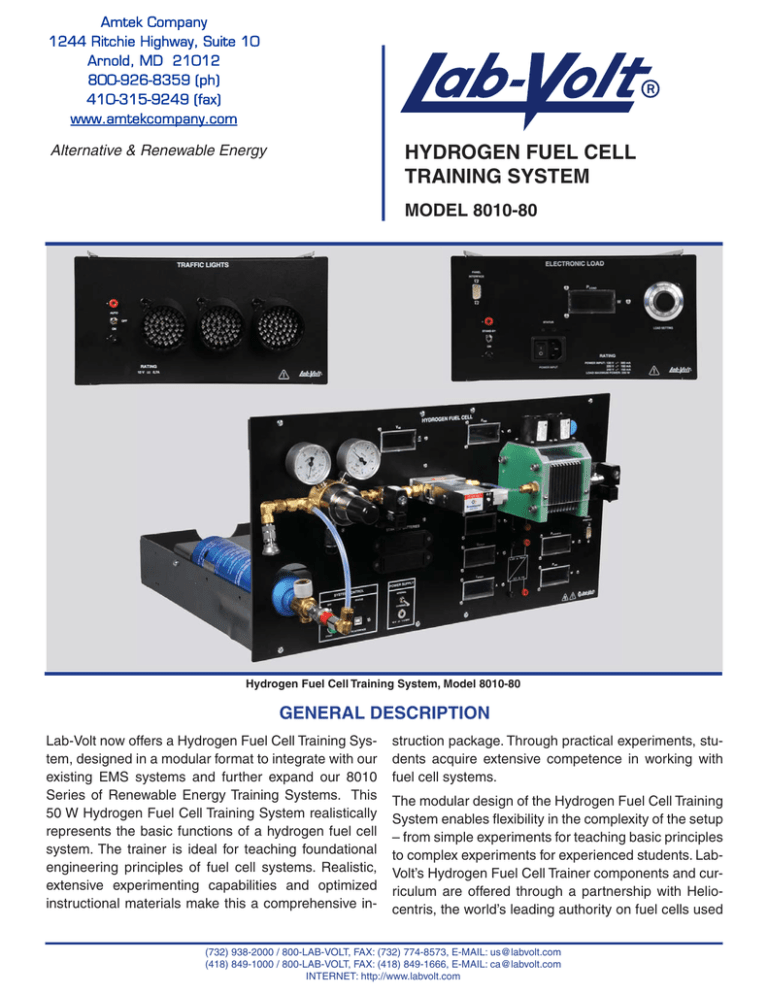
Amtek Company
1244 Ritchie Highway, Suite 10
Arnold, MD 21012
800-926-8359 (ph)
410-315-9249 (fax)
www.amtekcompany.com
Alternative & Renewable Energy
HYDROGEN FUEL CELL
TRAINING SYSTEM
MODEL 8010-80
Hydrogen Fuel Cell Training System, Model 8010-80
GENERAL DESCRIPTION
Lab-Volt now offers a Hydrogen Fuel Cell Training System, designed in a modular format to integrate with our
existing EMS systems and further expand our 8010
Series of Renewable Energy Training Systems. This
50 W Hydrogen Fuel Cell Training System realistically
represents the basic functions of a hydrogen fuel cell
system. The trainer is ideal for teaching foundational
engineering principles of fuel cell systems. Realistic,
extensive experimenting capabilities and optimized
instructional materials make this a comprehensive in-
struction package. Through practical experiments, students acquire extensive competence in working with
fuel cell systems.
The modular design of the Hydrogen Fuel Cell Training
System enables flexibility in the complexity of the setup
– from simple experiments for teaching basic principles
to complex experiments for experienced students. LabVolt’s Hydrogen Fuel Cell Trainer components and curriculum are offered through a partnership with Heliocentris, the world’s leading authority on fuel cells used
(732) 938-2000 / 800-LAB-VOLT, FAX: (732) 774-8573, E-MAIL: us@labvolt.com
(418) 849-1000 / 800-LAB-VOLT, FAX: (418) 849-1666, E-MAIL: ca@labvolt.com
INTERNET: http://www.labvolt.com
HYDROGEN FUEL CELL TRAINING SYSTEM
MODEL 8010-80
in education. The system is suitable for hands-on learning in diverse fields of study and occupations, such as:
•
•
•
•
•
Electrical Engineering
Energy Engineering
Process Engineering
Mechanical Engineering
Automotive Engineering
This modular training system, which includes numerous prepared experiments, enables students and trainees to examine the design and functions of a real fuel
cell system.
The Model 8010-80 system is designed for maximum
technical safety. Developed especially for educational
purposes, the system is designed for safe and easy operation, even by inexperienced users. With this trainer,
students explore the engineering principles of a hydrogen fuel cell system, as well as advanced principles of
the overall relationships of the system including:
•
•
•
•
Structure and functioning principles
Thermodynamics
Characteristic curves and efficiency ratings
System and power electronics
SAFETY
The Hydrogen Fuel Cell Training System is designed
for maximum technical safety. Developed especially
for universities and vocational institutions, the system
is designed for safe and easy operation by inexperienced and experienced users. In case of overloads or
irregularities, the trainer shuts down automatically and
locks the hydrogen supply. Therefore, you can take the
system to its limits without the risk of safety hazards or
damage.
TABLE OF CONTENTS
General Description ......................................... 1
Experiments .................................................... 2
Equipment List ................................................. 3
Module Description .......................................... 3
Specifications .................................................. 5
EXPERIMENTS
Theory
Practice
• Introduction to the operation of a fuel cell system
• Set-up and operation of an autonomous power supply
• Characteristic curve and output curve of the fuel cell
• Efficiency of the fuel cell system
• Dependence of output on air supply and temperature
• Sample application of independent power supply: How
long can a fuel cell supply an autonomous consumer?
• Hydrogen/current characteristic curve of the fuel cell
• Efficiency analyses of the fuel cell stack
2
• Sample application for fuel cell car: Determination of
the fuel consumption based on the load profile
EQUIPMENT LIST FOR HYDROGEN FUEL CELL TRAINING SYSTEM, MODEL 8010-80
QTY
DESCRIPTION
ORDERING NUMBER
1
Workstation (Three Modules) .................................................................................................................8131
1
Traffic Lights Module...............................................................................................................................8380
1
Electronic Load Module ..........................................................................................................................8381
1
Hydrogen Fuel Cell Module ....................................................................................................................8803
1
Metal Hydride Storage Canister ...........................................................................................................87948
1
Hydrogen Generator (Optional) ..............................................................................................................8894
1
User Manual ............................................................................................................................................TBE
MODULE DESCRIPTION
Model 8131 – Three-Module Workstation
Model 8380 – Traffic Light Module
The Three-Module Workstation, Model 8131 is intended for use on a bench and is fitted with wooden feet to
To simulate a real-world application of fuel cell electricprotect the bench top (not supplied). The Three-Module
ity production, this model traffic light can be attached
Workstation consists of a single row of three full-height
as a 12 V load.
compartments that can accommodate up to three fullsize EMS modules or six half-size EMS modules.
Model 8381 – Electronic Load Module
The Three-Module Workstation features a front mounted release lever and a safety locking device for each
compartment and holes in the rear panel of the workstation with removable cover plates. The Three- Module
Workstation requires assembly. A diagram is provided
with the workstation to facilitate assembly.
The Electronic Load Module provides manual or computer-assisted adjustment of constant rated currents
for the fuel cell for recording characteristic curves. Using manual procedures or a PC program, users can investigate the effect of different parameters on the characteristic curves of a fuel cell.
3
HYDROGEN FUEL CELL TRAINING SYSTEM
MODEL 8010-80
Model 8803 – Hydrogen Fuel Cell
A 50 W fuel cell stack with a fuel cell controller, hydrogen flow meter, a DC-DC converter (to obtain a regulated DC output from the stack), and air supply, as well as
seven LED displays for visualization of all essential system parameters (current, voltage, temperature, fuel, and air supply). The system also includes a 200 bar pressure
reducer with connecting tubes to refill the hydrogen canister or to connect a standard
compressed gas cylinder.
A USB port on the front panel enables use of the included data acquisition software to
perform further analysis on the fuel cell stack. This software provides support for the
experiments (visualization, data logging, fully automated experiments), in the manual.
Model 87948 – Metal Hydride Storage Canister
The Metal Hydride Storage Canister stores the hydrogen required for multiple experiments without
having to recharge from a compressed hydrogen cylinder. The canister is delivered empty and must be
refilled from compressed hydrogen gas canisters or
a hydrogen generator.
4
SPECIFICATIONS
Model 8131-10 – Three-Module Workstation
Physical Characteristics
Dimensions (H x W x D) 375 x 930 x 530 mm (14.8 x 36.6 x 20.9 in)
Weight 22.7 kg (50 lb)
Model 8380 – Traffic Light
Input Voltage
12 V DC
Power Consumption Max.
10 W
Physical Characteristics
Dimensions (H x W x D) 154 x 287 x 440 mm (6.1 x 11.3 x 17.3 in)
Net Weight TBE
Model 8381 – Electronic Load
Maximum continuous power output
200 W
Load voltage
1.2 – 20 V DC
Load current
0 – 10 A
Mains connection
120 – 240 V (50 – 60 Hz)
Physical Characteristics
Dimensions (H x W x D) 154 x 287 x 440 mm (6.1 x 11.3 x 17.3 in)
Net Weight TBE
Model 8803 – Hydrogen Fuel Cell
Rated Output
40 W
Maximum Output
50 W
No-Load Voltage
9V
Current at Rated Output
8A
Hydrogen Consumption at Rated Output
580 Nml/min
Hydrogen Purity for Operation
4.0 minimum (99.99%)
Permissible Hydrogen Pressure
0.4 – 0.8 bar
Permissible Ambient Temperature during Operation
+5 – 35° Celsius
Communication Port
USB
Pressure Regulator
2-Stage, Hydrogen
Inlet Pressure max. 19 bar
Outlet Pressure 0.6 ± 0.1 bar
H2 Cylinder Connection Kit
1-Stage Hydrogen Pressure Regulator
Max. Inlet Pressure 200 bar
Max. Outlet Pressure 17 bar
Connection CGA
Accessories
Physical Characteristics
Leak Detection Kit
Safety Connection Leads
Software
Dimensions (H x W x D) 307 x 579 x 533 mm (12.1 x 22.8 x 21 in)
Net Weight TBE
5
HYDROGEN FUEL CELL TRAINING SYSTEM
MODEL 8010-80
Model 87948 – Metal Hydride Storage Canisters
Storage Capacity (at charge pressure of 17 bar)
250 Nl
Output
1.7 sl/min
Charge Pressure
10 ... 17 bar
Charge Time
1 hr. at normal ambient temperature and active cooling
Model 8894 - Hydrogen Generator
Hydrogen Production
30 sl/h
Power Consumption
300 VA
Hydrogen Purity
6.0 (99.9999%)
Hydrogen Pressure
0.1 ... 10.7 bar
Power Input
115/230 V – 50/60 Hz
Physical Characteristics
Dimensions (H x W x D) 410 x 230 x 355 mm (16.1 x 9.1 x 14 in)
Net Weight 19 kg (41.88 lb)
Reflecting Lab-Volt’s commitment to high quality standards in product, design, development, production, installation, and service, our manufacturing and
distribution facility has received the ISO 9001 certification.
Lab-Volt reserves the right to make product improvements at any time and without notice and is not responsible for typographical errors. Lab-Volt recognizes all product names used herein as trademarks or registered trademarks of their respective holders. © Lab-Volt 2011. All rights reserved.
88119-00





